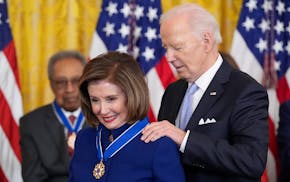Summer Hours at the Robbers Library
By Sue Halpern. (Harper Perennial, 368 pages, $15.99.)
The Robbers Library is a misnomer, one of the characters in Sue Halpern's latest novel says — the name was actually Robers Library, named for the robber baron who helped start the New Hampshire factory town where this gentle book is set. But it is appropriate that the library, where much of the action takes place, is misnamed because in this novel no one is who they seem. Everyone has secrets.
The librarian, Kit, has fled to this dying town to avoid the scandal of her shattered marriage. Sunny, the teenager who is sentenced to perform community service at the library (for the charming crime of shoplifting a dictionary), is the daughter of hippies — one of whom is leading a double life. Rusty, the handsome stranger who motors into town in his speedy sports car, is a failed Wall Street power broker, here looking for a fortune perhaps left behind by his adoptive parents.
Even the four retired guys who treat the library as their private club have secrets — or one of them does, anyway.
"Summer Hours at the Robbers Library" has ambitions. Halpern touches on themes of greed, home schooling, the back-to-the-land movement, animal rights, immigration, happiness and love. But she is careful not to weigh down her story, which is both light and action-packed.
It veers into melodrama (murder! a convenient bequest! a terrible fire!) but she handles it ably. A fun read, and she gets the atmosphere of the old Carnegie Library exactly right.
LAURIE HERTZEL
My Betsy-Tacy Miracle: A Literary Pilgrimage to Deep Valley
By Kathleen Baxter. (Minnesota Heritage Publishing, 80 pages, $12.)
Rare is the Minnesota woman of a certain vintage who hasn't been swept up by the children's books about friends Betsy and Tacy. Kathleen Baxter is one; in this slim volume she tells the 50-plus-year-old tale of her journey to Deep Valley (Mankato, to you and me). Her quest to find the stories behind the stories (aided by some impressive pre-internet sleuthing) eventually led to meetups and correspondence with some of the real folks involved, including author Maud Hart Lovelace. As Lovelace's alter ego Betsy might say, it was quite a grand adventure. Who wouldn't want to have tea with Carney, or a ride in Cab Edwards' Cadillac, or tour the High Street house and envision Julia Ray at the piano? We'll have to live vicariously, as the people — and many of the buildings — are long gone.
Half of the book is studded with historical photos, newspaper clippings and letters, which give the feel of a scrapbook (which, in a way, it is). The prose is a bit amateurish and breathless, but darned if a reader isn't inspired to finally embark on her own pilgrimage to Mankato (where, thanks to the Betsy-Tacy Society, there now is a cottage industry sprung up around the series). And of course, to reread those marvelous books.
CYNTHIA DICKISON

Helen Simonson is in Jane Austen mode with 'The Hazelbourne Ladies Motorcycle and Flying Club'
New Orleans' own PJ Morton returns home to Jazz Fest with new music

Biden awards the Medal of Freedom to Nancy Pelosi, Medgar Evers, Michelle Yeoh and 15 others

